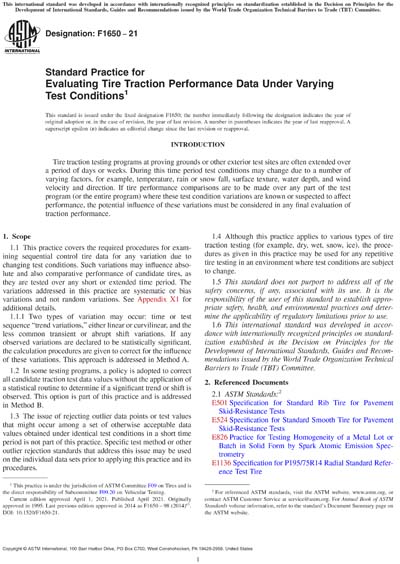Most recent
ASTM F1650-21
Standard Practice for Evaluating Tire Traction Performance Data Under Varying Test Conditions
1.1 This practice covers the required procedures for examining sequential control tire data for any variation due to changing test conditions. Such variations may influence absolute and also comparative performance of candidate tires, as they are tested over any short or extended time period. The variations addressed in this practice are systematic or bias variations and not random variations. See Appendix X1 for additional details.
1.1.1 Two types of variation may occur: time or test sequence “trend variations,†either linear or curvilinear, and the less common transient or abrupt shift variations. If any observed variations are declared to be statistically significant, the calculation procedures are given to correct for the influence of these variations. This approach is addressed in Method A.
1.2 In some testing programs, a policy is adopted to correct all candidate traction test data values without the application of a statistical routine to determine if a significant trend or shift is observed. This option is part of this practice and is addressed in Method B.
1.3 The issue of rejecting outlier data points or test values that might occur among a set of otherwise acceptable data values obtained under identical test conditions in a short time period is not part of this practice. Specific test method or other outlier rejection standards that address this issue may be used on the individual data sets prior to applying this practice and its procedures.
1.4 Although this practice applies to various types of tire traction testing (for example, dry, wet, snow, ice), the procedures as given in this practice may be used for any repetitive tire testing in an environment where test conditions are subject to change.
1.5 This standard does not purport to address all of the safety concerns, if any, associated with its use. It is the responsibility of the user of this standard to establish appropriate safety, health, and environmental practices and determine the applicability of regulatory limitations prior to use.
1.6 This international standard was developed in accordance with internationally recognized principles on standardization established in the Decision on Principles for the Development of International Standards, Guides and Recommendations issued by the World Trade Organization Technical Barriers to Trade (TBT) Committee.
Content Provider
ASTM International [astm]






